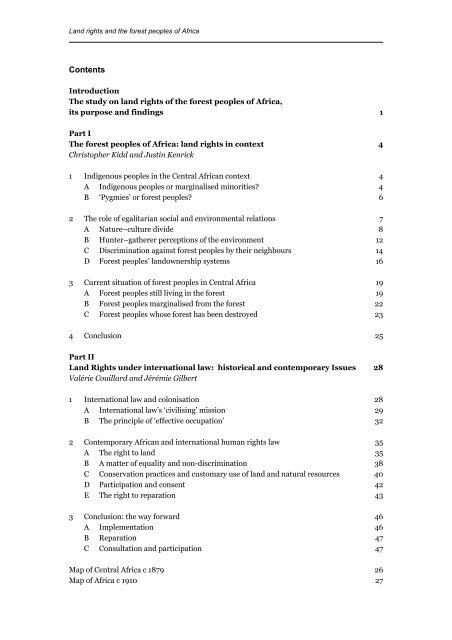Land Rights and the Forest Peoples of Africa
Land Rights and the Forest Peoples of Africa
Land Rights and the Forest Peoples of Africa
Create successful ePaper yourself
Turn your PDF publications into a flip-book with our unique Google optimized e-Paper software.
<strong>L<strong>and</strong></strong> rights <strong>and</strong> <strong>the</strong> forest peoples <strong>of</strong> <strong>Africa</strong><br />
Contents<br />
Introduction<br />
The study on l<strong>and</strong> rights <strong>of</strong> <strong>the</strong> forest peoples <strong>of</strong> <strong>Africa</strong>,<br />
its purpose <strong>and</strong> findings 1<br />
Part I<br />
The forest peoples <strong>of</strong> <strong>Africa</strong>: l<strong>and</strong> rights in context 4<br />
Christopher Kidd <strong>and</strong> Justin Kenrick<br />
1 Indigenous peoples in <strong>the</strong> Central <strong>Africa</strong>n context 4<br />
A Indigenous peoples or marginalised minorities 4<br />
B ‘Pygmies’ or forest peoples 6<br />
2 The role <strong>of</strong> egalitarian social <strong>and</strong> environmental relations 7<br />
A Nature–culture divide 8<br />
B Hunter–ga<strong>the</strong>rer perceptions <strong>of</strong> <strong>the</strong> environment 12<br />
C Discrimination against forest peoples by <strong>the</strong>ir neighbours 14<br />
D <strong>Forest</strong> peoples’ l<strong>and</strong>ownership systems 16<br />
3 Current situation <strong>of</strong> forest peoples in Central <strong>Africa</strong> 19<br />
A <strong>Forest</strong> peoples still living in <strong>the</strong> forest 19<br />
B <strong>Forest</strong> peoples marginalised from <strong>the</strong> forest 22<br />
C <strong>Forest</strong> peoples whose forest has been destroyed 23<br />
4 Conclusion 25<br />
Part II<br />
<strong>L<strong>and</strong></strong> <strong>Rights</strong> under international law: historical <strong>and</strong> contemporary Issues 28<br />
Valérie Couillard <strong>and</strong> Jérémie Gilbert<br />
1 International law <strong>and</strong> colonisation 28<br />
A International law’s ‘civilising’ mission 29<br />
B The principle <strong>of</strong> ‘effective occupation’ 32<br />
2 Contemporary <strong>Africa</strong>n <strong>and</strong> international human rights law 35<br />
A The right to l<strong>and</strong> 35<br />
B A matter <strong>of</strong> equality <strong>and</strong> non-discrimination 38<br />
C Conservation practices <strong>and</strong> customary use <strong>of</strong> l<strong>and</strong> <strong>and</strong> natural resources 40<br />
D Participation <strong>and</strong> consent 42<br />
E The right to reparation 43<br />
3 Conclusion: <strong>the</strong> way forward 46<br />
A Implementation 46<br />
B Reparation 47<br />
C Consultation <strong>and</strong> participation 47<br />
Map <strong>of</strong> Central <strong>Africa</strong> c 1879 26<br />
Map <strong>of</strong> <strong>Africa</strong> c 1910 27





